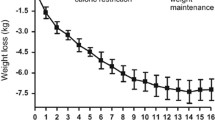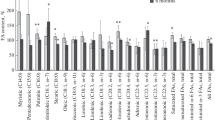Summary
Thirty-one weight-stable patients with different types of hyperlipoproteinemia were treated daily with 4g nicotinic acid for 6 weeks. Effects of this therapy on adipose tissue metabolism were evaluated. By using biopsy specimens of subcutaneous adipose tissue, fatty acid and glucose incorporation into adipose tissue glycerides were measured in vitro as well as glycerol and fatty acid release, which allowed us to estimate adipose tissue lipolysis. The amount of fatty acids produced by lipolysis and thereafter utilized within adipose tissue without being released (fatty acid retention) was estimated. Fatty acid and glucose incorporation into adipose tissue, glycerol release and fatty acid retention values increased, but serum triglyceride levels decreased (allP<0.001) after nicotinic acid treatment. The change in fatty acid incorporation was positively correlated with changes in glucose incorporation into adipose tissue (r=0.53,P<0.01) and fatty acid retention (r=0.76,P<0.001). Although adipose tissue lipolysis, measured as glycerol release, increased, the lipolyzed fatty acids were retained in adipose tissue, suggesting an enhanced synthesis of glycerides both from exogenous and endogenous sources. The increase in fatty acid incorporation into adipose tissue indicates that the decrease in serum triglyceride levels produced by nicotinic acid treatment may partly be due to the fact that this drug promotes incorporation of fatty acids, derived from lipoprotein-carried triglycerides in the blood, into adipose tissue glycerides.
Similar content being viewed by others
References
Bally PR, Kappeler H, Froesch ER, Labhart A, Effect of glucose on spontaneous limitation of lipolysis in isolated adipose tissue: a potential regulatory mechanism. Ann N Y Acad Sci 131:143, 1965
Beaumont J-L, Carlson LA, Cooper GR, Pfeiffer Z, Fredrickson DS, Strasse T, Classification of hyperlipidaemias and hyperlipoproteinaemias. Bull WHO 43:891, 1970
Björntorp P, Inhibition of lipase activation in rat epididymal fat pads in vitro. Am J Physiol 210:733, 1966
Björntorp P, How should obesity be defined. Editorial. J Intern Med 227:147, 1990
Björntorp P, Östman J, Human adipose tissue dynamics and regulation. Adv Metab Dis 5:277, 1971
Boberg J, Carlson LA, Fröberg S, Olsson A, Orö L, Rössner S, Effects of chronic treatment with nicotinic acid on intravenous fat tolerance and postheparin lipoprotein lipase activity in man. In: Gey HF, Carlson LA (eds) Metabolic effects of nicotinic acid and its derivatives. Huber, Bern, pp 465–470, 1971
Carlson K, Lipoprotein fractionation. J Clin Pathol 26 [Suppl 5]:32, 1973
Carlson LA, Studies on the effect of nicotinic acid on catecholamine stimulated lipolysis in adipose tissue in vitro. Acta Med Scand 173:719, 1963
Carlson LA, Inhibition of the mobilization of free fatty acids from adipose tissue. Ann N Y Acad Sci 131:119, 1965
Carlson LA, Consequences of inhibition of normal and excessive lipid mobilization. Progr Biochem Pharmacol 3:151, 1967
Carlson LA, The effect of nicotinic acid treatment on the chemical composition of plasma lipoprotein classes in man. Drugs affecting lipid metabolism. Adv Exp Med Biol 4:327, 1969
Carlson LA, Nicotinic acid: its metabolism and its effects on plasma free fatty acids. In: Gey KF, Carlson LA (eds) Metabolic effects of nicotinic acid and its derivatives. Huber, Bern, pp 158–165, 1971
Carlson LA, Effect of nicotinic acid on serum lipid and lipoproteins. In: Carlson LA, Olsson AG (eds) Effect of nicotinic acid on serum lipids and lipoproteins. Raven, New York, pp 115–119, 1984
Carlson LA, Walldius G, Fatty acid incorporation into human adipose tissue in hypertriglyceridaemia. Eur J Clin Invest 6:195, 1976
Carlson LA, Eriksson I, Walldius G, A case of massive hypertriglyceridaemia and impaired fatty acid incorporation into adipose tissue glycerides (FIAT), both corrected by nicotinic acid. Acta Med Scand 194:363, 1973
Chernik SS, Determination of glycerol in acyl glycerols. In: Colowick SP, Kaplan NO (eds) Methods of enzymology. XIV. Academic Press, New York, pp 627–630, 1969
Eckel RH, Lipoprotein lipase. A multifunctional enzyme relevant to common metabolic diseases. N Engl J Med 320:1060, 1989
Efendic S, Östman J, Catecholamines and metabolism of human adipose tissue. IV. Influence of glucose on catecholamine induced lipolysis in human omental adipose tissue in vitro. Acta Med Scand 187:485, 1970
Ferranini E, Barrett EJ, Bevilaqua S, DeFronzo RA, Effect of fatty acids on glucose production and utilization in man. J Clin Invest 72:1737, 1983
Fletcher MJ, A calorimetric method for estimating serum triglycerides. Clin Chim Acta 22:393, 1968
Fröberg SO, Boberg J, Carlson LA, Eriksson M, Effect of nicotinic acid on the diurnal variation of plasma levels of glucose, free fatty acids, triglycerides and cholesterol and of urinary excretion of catecholamines. In: Gey KF, Carlson LA (eds) Metabolic effects of nicotinic acid and its derivatives. Huber, Bern, pp 167–181, 1971
Groop LC, Bonnadonna RC, DelPrato S, Ratheiser K, Zyck K, Ferranini E, DeFronzo RA, Glucose and free fatty acid metabolism in non-insulin-dependent diabetes mellitus. J Clin Invest 84:205, 1989
Grundy SM, Pathogenesis of hypertriglyceridemia in man. In: Carlson LA, Olsson AG (eds) Treatment of hyperlipoproteinemia. Raven, New York, pp 21–34, 1984
Grundy SM, Mok HYI, Zech L, Berman M, Influence of nicotinic acid on metabolism of cholesterol and triglycerides in man. J Lipid Res 22:24, 1981
Ho RJ, Biochemical assay of long-chain fatty acids using63Ni as tracer. Anal Biochem 36:105, 1970
Ho RJ, Jeanrenaud B, Insulin-like action of ouabain. I. Effect on carbohydrate metabolism. Biochim Biophys Acta 144:61, 1967
Kahn SE, Beard JC, Schwartz MW, Ward WK, Ding HL, Bergman RN, Taborsky GJ Jr, Porte D Jr, Increased β-cell secretory capacity as mechanism for islet adaptation to nicotinic acid-induced insulin resistance. Diabetes 38:562, 1989
Kudchodkar BJ, Sodhi HS, Horlick L, Mason DT, Mechanisms of hypolipidemic action of nicotinic acid. Clin Pharmacol Ther 24:354, 1978
Lee HM, Ellis RM, Sigal MV Jr, Some insulin-like effects of nicotinic acid observed with isolated rat epididymal adipose tissue. Biochim Biophys Acta 49:408, 1961
Miettinen TA, Taskinen M-R, Pelkonen R, Nikkilä EA, Glucose tolerance and plasma insulin in man during acute and chronic administration of nicotinic acid. Acta Med Scand 186:247, 1969
Nikkilä EA, Pykälistö O, Induction of adipose tissue lipoprotein lipase by nicotinic acid. Biochim Biophys Acta 152:421, 1968
Pereira JN, The plasma free fatty acid rebound induced by nicotinic acid. J Lipid Res 8:239, 1967
Snedecor GW, Cochran WG, Statistical methods, 7th edn. The Iowa State University Press, Iowa 1980
Solyom A, Puglisi L, Effect in vitro of nicotinic acid on triglyceride synthesis in rat adipose tissue. Biochem Pharmacol 15:41, 1966
Streffer C, Brauer W, Benes J, Levels of pyridine nucleotides after repeated applications of nicotinic acid in animal tissues. In: Gey KF, Carlson LA (eds) Metabolic effects of nicotinic acid and its derivatives. Huber, Bern, pp 97–114, 1971
Vaughan M, The production and release of glycerol by adipose tissue incubated in vitro. J Biol Chem 237:3354, 1962
Vaughan M, Steinberg D, Pittman R, On the interpretation of studies measuring uptake and esterification of (I-14C) palmitic acid by rat adipose tissue in vitro. Biochim Biophys Acta 84:154, 1965
Wahlberg G, Carlson LA, Wasserman J, Ljungqvist A, Protective effect of nicotinamide against nephropathy in diabetic rats. Diabetes Res 2:307, 1985
Wahlberg G, Walldius G, Efendic S, Effects of nicotinic acid on glucose tolerance and glucose uptake into adipose tissue. Scand J Clin Lab Invest 52:537, 1992
Walldius G, Fatty acid incorporation into human adipose tissue (FIAT) in hypertriglyceridaemia. Methodological, clinical and experimental studies. Acta Med Scand [Suppl] 4:591, 1976
Walldius G, What happens after lipoprotein lipase? A low fatty acid incorporation into adipose tissue (FIAT) in hypertriglyceridaemia— experimental and clinical studies. Int J Obes 5:707, 1981
Walldius G, Rössner S, Effects of nicotinic acid on the intravenous fat tolerance test (IVFTT) and fatty acid incorporation into adipose tissue (FIAT) in hypertriglyceridemia (HTG) (abstract). In Kritchewsky D, Paoletti R, Holmes WL (eds) Proceedings of the Fifth International Symposium on Drugs Affecting Lipid Metabolism, Sept 9–12, 1975. Plenum, New York, p 491
Walldius G, Rubba P, A micro-method for determination of fatty acid (FIAT) and glucose (GLIAT) incorporation and lipolysis in vitro in needle biopsies of human adipose tissue. Scand J Clin Lab Invest 36:357, 1976
Walldius G, Carlson LA, Lithell, Olsson AG, Rubba P, Vessby B, Impaired fatty acid incorporation into adipose tissue (FIAT) in hypertriglyceridemia. Effect of intravenous fat infusion on FIAT. In: Schettler G, Weizel A (eds) Atherosclerosis. III. Springer, Berlin Heidelberg New York, pp 524–528, 1974
Zlatkis A, Zak B, Boyle J, A new method for direct determination of serum cholesterol. J Lab Clin Med 41:486, 1953
Author information
Authors and Affiliations
Rights and permissions
About this article
Cite this article
Wahlberg, G., Walldius, G. Effects of nicotinic acid treatment on glyceride formation and lipolysis in adipose tissue of hyperlipidemic patients. Int J Clin Lab Res 23, 88–94 (1993). https://doi.org/10.1007/BF02592289
Issue Date:
DOI: https://doi.org/10.1007/BF02592289




